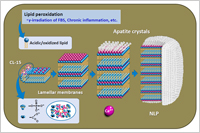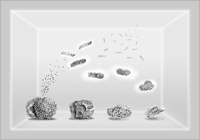Enlarge Image A proposed propagation cycle in the culture system, illustrating two modes of propagation. Rod-shaped NLPs were detected mainly as a floating form and spherical NLPs with characteristic apatite shells were detected as an attached form. In addition to characteristic lamellar structures composed of oxidized lipids, apatite nanocrystals from developed-spherical NLP are key elemental seeds for the acceleration of NLP propagation.
Enlarge Image
Naturally occurring nanobacteria-like particles and ectopic calcification: importance of common nanoparticle scaffolds containing oxidized acidic lipids.
Nanobacteria (NB) is the name proposed for a class of living organisms with dimensions much less than the generally accepted lower limit size for living organisms, which is about 200 nanometers for bacteria. Since their discovery by Kajander et al. in 1997, NB have undergone changes in nomenclature that include nanobacteria-like particles (NLPs), nanobes, and calcifying nanoparticles (CNP), based on their properties.
Several in vitro experiments, including the failure to identify an NB genome by nucleic acid sequencing methods, have clearly ruled out their existence as bona fide living organisms. However, a number of recent studies still claim the presence of living NB to be associated with the pathogenesis and development of diverse diseases, which are related to ectopic calcification defined as inappropriate biomineralization occurring in soft tissues.
Ultrastructural and elemental analyses, combining immuno-electron microscopy with an original NLP isolate (P-17) derived from urinary stones, and an IgM monoclonal antibody (CL-15) raised against P-17 revealed that, oxidized lipids with acidified functional groups were key elements in NLP propagation [1,2]. Characteristic lamellar structures composed of oxidized lipids having calcium-chelating activity constituted structural scaffolds for carbonate apatite crystals of NLPs.
This new finding clearly explains why morphologically uniform rod-shaped NLPs appear to self-propagate like an organism and how spherical NLPs with characteristic shells develop in the culture system. During in vitro culture, lipid peroxidation induced by γ-irradiation of fetal bovine serum was a major cause of accelerated NLP propagation. During pathogenic processes, lipid peroxidation initated by free radicals is responsible for the production of these oxidized lipids. We demonstrated that oxidized lipids could form a common platform for ectopic calcification in atherosclerosis-prone (ApoE-/-) mice as a well-established disease model.
These observations indicate that naturally occurring NLP composed of mineralo-oxidized lipids complexes are generated as byproducts of chronic inflammation, rather than etiological agents.
Reference:
1. Kumon H, Matsumoto A, Uehara S, Abarzua F, Araki M, Tsutsui K et al.
Detection and isolation of nanobacteria-like particles from Urinary stones: Long-withheld data. Intl J Urol 2011; 18: 458-65.
http://onlinelibrary.wiley.com/doi/10.1111/j.1442-2042.2011.02763.x/pdf
2. Kumon H, Matsuura E, Nagaoka N, Yamamoto T, Uehara S, Araki M et al. et al.
Ectopic calcification: importance of common nanoparticle scaffolds containing oxidized acidic lipids. Nanomedicine. 2013 Sep 9. pii: S1549-9634(13)00472-3. doi: 10.1016/j.nano.2013.08.010. [Epub ahead of print]


